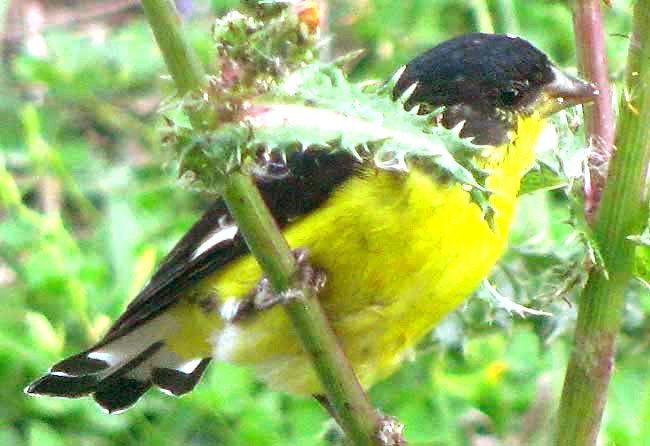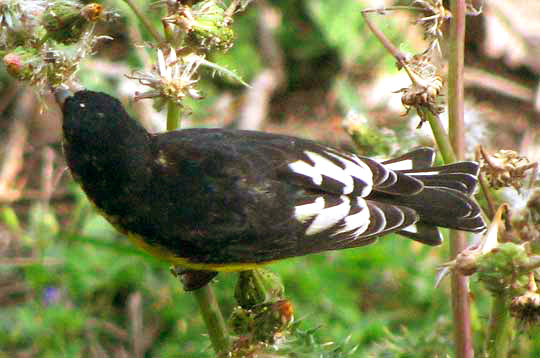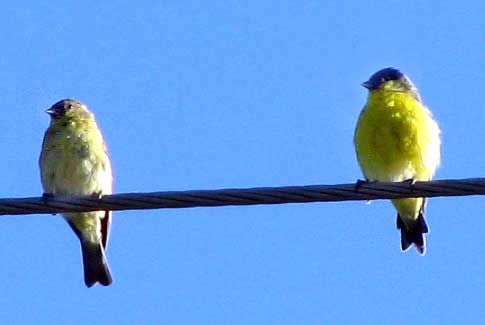Excerpts from Jim Conrad's
Naturalist Newsletter

from the the April 21, 2013 Newsletter issued from the Frio Canyon Nature Education Center in northern Uvalde County, southwestern Texas, on the southern border of the Edwards Plateau; elevation ~1750m (~5750 ft); N29.62°, W99.86°; USA
LESSER GOLDFINCH
Once again foraging among the sow thistles below my kitchen window a bird species showed up that most American birders, unless they're in the US's arid Southwest or western coastal region, just never see. Above you can see it, its beak sticky with white latex that's oozed from the sow thistle's tissue injured by the bird's foraging.
Even if you've never seen this species, with its small size, thick, short beak, yellow underparts and black top, this bird might remind you of a goldfinch, which it is. However, it's not the American Goldfinch so common in many habitats from coast to coast in the US and adjacent Canada. It's the Lesser Goldfinch, CARDUELIS PSALTRIA, common in arid environments from northern South America north to the southwestern US and the Pacific coast states as far north as southern Washington. Below you can see how different the male Lesser's top parts are from those of the American Goldfinch:

Male American Goldfinches are bright yellow above, except for a black forehead.
In more northern parts of the US Southwest, Lesser Goldfinches are only summer residents, withdrawing south during the winter. However, here in southwestern Texas, they're permanent residents, as they are in Latin America.
In the US, Lesser Goldfinches occur in two color forms. Ours with its males sporting all-black backs is the "Texas form," while farther west the males' backs turn gray-green, or olive, constituting the "Western form."
The Lesser Goldfinch is lesser because it's smaller than the American species. American Goldfinches are about 4¼ inches long (11.5cm) while the Lesser is only 3¾ inches (9.5cm). In the West the two species sometimes turn up together at birdfeeders.
from the September 6, 2009 Newsletter, issued from the Siskiyou Mountains west of Grants Pass, Oregon:
A GOOD TIME FOR FINCHES
Here at the dry season's end the landscape mellows into endless ripenings of seed and fruit. In rural areas along roads and field edges, grasses offer a bounty for grain eaters. Everywhere elegant grass inflorescences nod in breezes, holding aloft tiny, hard grains enfolded in dry, dun-colored chaff, the neat glumes, lemmas and paleas of grass flowers. It's a good time for small songbirds who land among the flimsy inflorescences and eat the grains, spending much time grinding their beaks back and forth husking off the chaff and mashing the seeds.
No bird group is more at home inside a grass inflorescence than the Finch Family, and in North America maybe the best-known and most beloved finches are the bright yellow and black goldfinches, the American Goldfinch distributed from coast-to-coast, and the Lesser Goldfinch of the west and south-central states.
During this week's backpacking hike for the first 15 miles I walked along roads through the valley before climbing into mountains and following Forest Service logging roads back home. Again and again small flocks of Lesser Goldfinches, CARDUELIS PSALTRIA, turned up wherever grasses had gone unmowed, and in blackberry thickets. There's so much for them to eat that often long rows of them perched basking on power lines above their meals. Two perching on a line are shown below:

The mature male on the right calls his thin, high-pitched teeeyooo as the juvenile on the left seems to be rolling his eyes like any good adolescent. Of course that's grossly anthropomorphic, so you can interpret the image yourself.
Lesser Goldfinches are so named because they're half an inch (1+ cm) smaller than American Goldfinches, who are small birds to begin with. You can distinguish the male Lesser in the picture from a mature male American Goldfinch because the black on the latter's head is restricted to the forehead, while the Lesser's blackness continues over the crown and down the back.
Lesser Goldfinches are common in upland central Mexico, too, but Americans don't get that far south. Down there, male Lessers have pure black backs, while you can see that our male's nape pales to a greenish gray. Our pale-backed geographical variation is limited to the US far West, and northwestern Mexico.